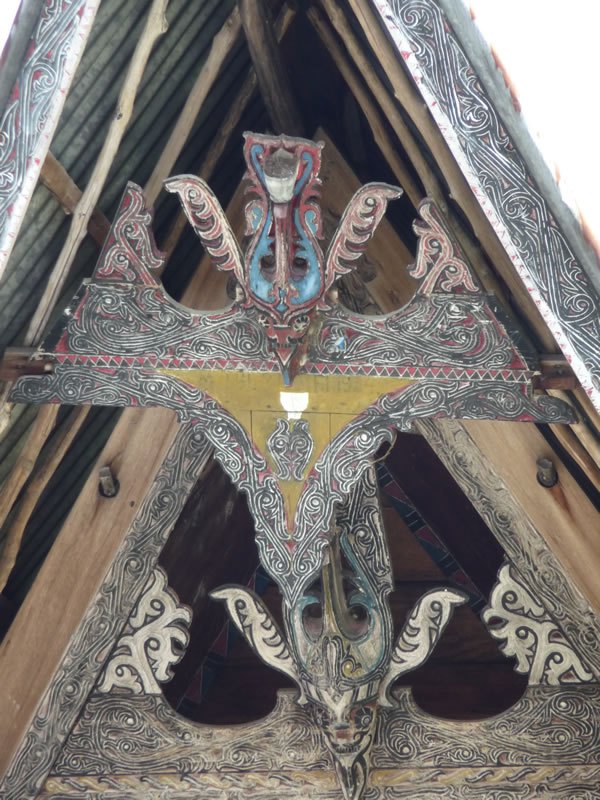Batak Carvings

A traditional Batak house, with high peaks and walls that lean outwards.
North Sumatra is still dotted with clusters of beautiful traditional houses, called umah godang, long houses on stilts with boat-shaped roofs and distinct sculptural features. Each umah godang is also paired with a rice barn called a sopo, which stands facing the main house across a central square. The arrangement is similar to traditional villages in Tana Toraja, in the mountains of central Sulawesi.
Most umah godang houses share a few decorative elements that have deep roots in Batak culture. Near the roof peak at the front of the house, a pair of masks stand guard over the entrance, one male and one female, distinguishable by the fineness of their features and the bulge of their eyes. These masks may be called either jaga dopak-protectors-or gaja dopak-elephants; we heard both answers from different people.

A pair of masks on the front of a traditional house.

A singa singa at the corner of a house.
The ends of the main floor joists are carved where they emerge at the front of the house. These figures, calledsinga singa, are the most iconic images in Batak sculpture, with high foreheads, lined faces, and angular features. The forms of Singa singa can vary enough to be interpreted as humans, horses, or lions. Modern umah godang might occasionally have quite different figures carved in that spot.
Painted carvings often cover Batak houses. Vegetal scrolls painted red, white and black crawl along the edges and gather under the eaves, stylized forms of an aquatic grass called gunduk pahu. Some houses depict figures from Batak history and mythology, or more recent events, including the Indonesian War of Independence, fought from 1945 to 1949.

A house painted with scenes of Western life.

A pair of sculptures in the newer style, with more recognizably human features.
Batak carvers served a thriving tourist market until the first Bali Bomb slowed the flood of foreign visitors to a trickle. Shops in Parapat and Tuktuk are still crammed with versions of traditional Batak sculpture, which have been altered in subtle ways in an attempt to increase their appeal as souvenirs. These slicker, often finely carved pieces lack the essential spirit that gives Batak sculpture its power.
The search for master carvers took Pung, Jean, and Frog the village of Sosor Tolong. There they met a gifted carver named Tualim Sinaga. He offered a few pieces for sale which had been curing in the rafters above his kitchen fire for two or three years. The sculptures had acquired a black patina of soot and a faint odor of wood smoke.

Tualim Sinaga with some of his work.

This sandi sandi is about half a meter across.
The Threads of Life team purchased jaga dopak masks, medicine containers called sahang, and treasure boxes called sandi sandi. True sandi sandi can be as much as two meters long, and were used by Batak royalty both as thrones and as repositories for clan heirlooms. Sahang can be made from wood, bone, or buffalo horn, and would be hung from ceiling beams or carried like purses during ceremonial processions.
Although the Batak people have adopted Christianity, they still believe in the protective power of carved images. The most common motifs-geckos and lizards, singa singa and jaga dopak, and humans, especially riders mounted on mythical beasts-are guardians, intended to ward off malevolent spirits. Local traditional beliefs are called Parmalim. Recent missions by Charismatic Christian sects have urged their Batak converts reject Parmalim more forcefully, and to burn old textiles and carvings.

A smiling protector guards a traditional house.

